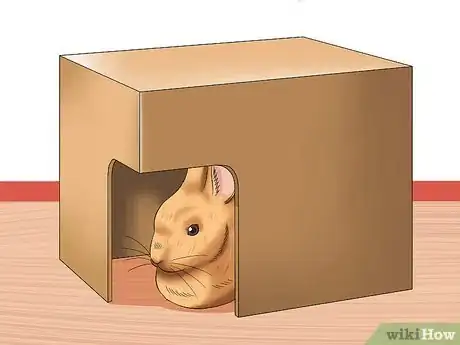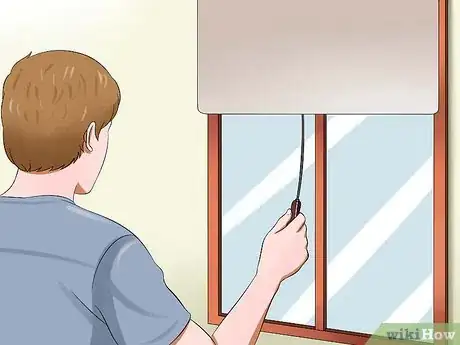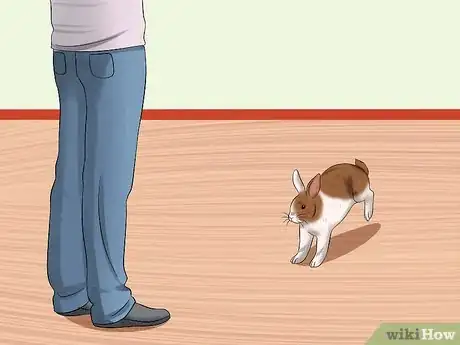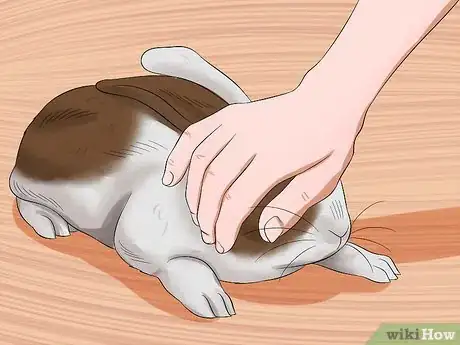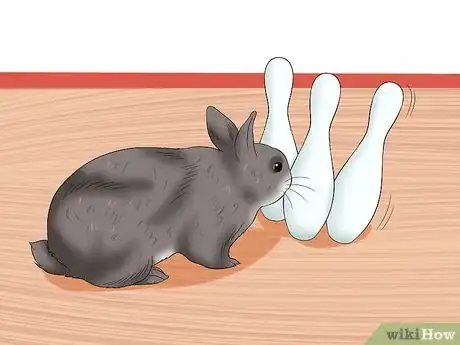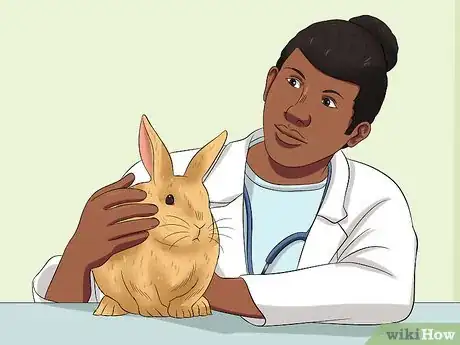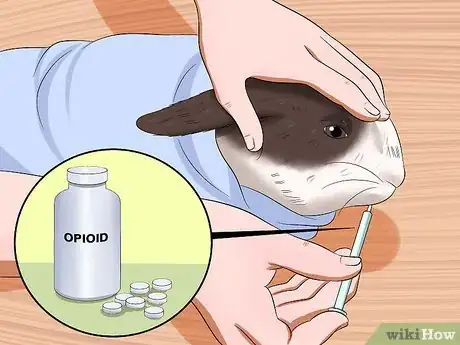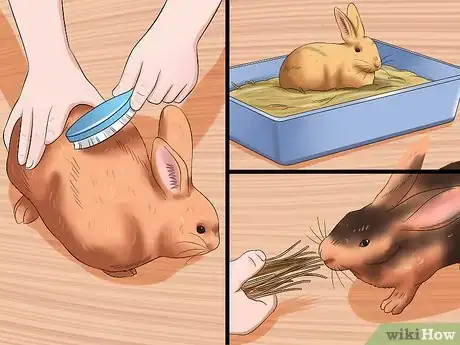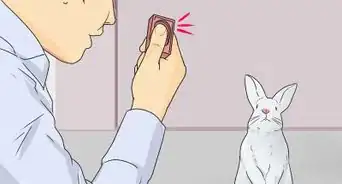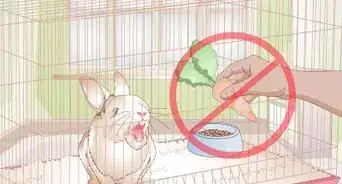This article was co-authored by Pippa Elliott, MRCVS. Dr. Elliott, BVMS, MRCVS is a veterinarian with over 30 years of experience in veterinary surgery and companion animal practice. She graduated from the University of Glasgow in 1987 with a degree in veterinary medicine and surgery. She has worked at the same animal clinic in her hometown for over 20 years.
There are 14 references cited in this article, which can be found at the bottom of the page.
This article has been viewed 53,127 times.
Rabbits, like other pets, can become frightened during thunderstorms. Whether you have an indoor or outdoor rabbit, a thunderstorm’s loud noise can make him feel very distressed. Rabbits can literally scare themselves to death, so it is very important for you to calm your rabbit during a thunderstorm.[1]
Steps
Providing a Safe Space for Your Rabbit During a Thunderstorm
-
1Look for signs of fright in your rabbit. Your rabbit can show fright in a number of different ways. Screaming is a very common way for rabbits to show fright. In addition, your rabbit may run back and forth in his hutch or other enclosure. He might also widen his eyes, bare his teeth, and flatten his ears against his head.
- Frightened rabbits may also stay motionless.
- You may notice your rabbit’s fur looking spiked up or puffed out if he is frightened.
- Other signs of fright include repeated circling in the cage or hutch, sitting in a hunched position, and chewing on cage bars.[2]
- If you notice any signs of fright in your rabbit during a thunderstorm, act quickly to calm him down.
-
2Bring your rabbit’s hutch inside. If you have an outdoor rabbit, he should be inside during a thunderstorm. Bring his entire hutch inside if you can. If the hutch is too large or cumbersome to bring inside your home, leave it outside and bring only your rabbit inside.
- If you cannot bring the hutch inside, prepare a comfortable caged area in your home for your rabbit, which should include comfortable bedding and some of his favorite toys. If you know the storm is coming, prepare the caged area well ahead of time.
- Leaving your rabbit outside in his hutch is not a good idea, even if you cover the hutch with a sheet or large blanket to block out some of the thunderstorm’s noise. Your rabbit would still become frightened, and you would not be able to detect his signs of fright.
Advertisement -
3Give your rabbit a safe, indoor hiding place. To calm your rabbit during a thunderstorm, you will need to set up an area where he can hide and feel safe until the storm is over. If you were able to bring his hutch inside, set up a cozy hiding area within the hutch that has lots of comfortable bedding. Within a caged area (or other type of enclosure), set up a separate hiding spot with bedding.
-
4Tune out the thunderstorm’s noise. Your rabbit may still be worked up if he can hear the thunder. Closing the widows and drawing the curtains can help drown out the noise. You can also turn on some white noise, such as an air conditioner or fan, or turn on some soothing music.[5]
Calming Your Rabbit Through Interaction
-
1Let your rabbit come to you. In addition to providing a comfortable physical space for your rabbit, you can also interact with him to calm him down. For example, your rabbit may want to be close to you to ease his fears. Let him come to you first, though. Rabbits can be very affectionate, but want to show their affection according to their own schedule and comfort level.
- Keep in mind that, in general, rabbits do not enjoy being handled or cuddled. If your rabbit is not comfortable with you holding him, simply sit quietly with him and let him be affectionate with you in his own way.
- If you have brought your rabbit’s hutch inside, consider leaving him in there until the storm calms down. He may be perfectly content to rest in the hutch’s hiding place, and may not want you to take him out and interact with him.
-
2Cover your rabbit’s eyes. If your rabbit doesn’t mind being close to you, try gently covering his eyes for a few moments. Reach from behind, with your fingers resting comfortably near his nose. Covering your rabbit’s eyes can help calm him down, at least momentarily.[6]
- If your rabbit is already in his hiding place, leave him be. You don’t want to cause him any more distress by forcing him out of his hiding place.
-
3Play games with your rabbit. If your rabbit is up to it, play some interactive games with him to distract him from the thunderstorm’s noise. Go bowling with your rabbit—set up some plastic bowling pins and let your rabbit knock them over with his nose. You can also play ‘reverse’ fetch with your rabbit—let him toss something towards you with his teeth.[7]
- Allow your rabbit to snatch something (e.g., piece of newspaper, junk mail) out of your hand and run away with it.[8]
- If your rabbit is taking a while to calm down, do not force him to play games with you. If he would rather lay quietly in his hiding place, let him do so.
Getting Help For Your Frightened Rabbit
-
1Determine if your rabbit will need veterinary care. If your rabbit is screaming or showing signs of fright that will not cause injury, you can continue helping him calm down at home. However, if he has gotten so worked up that he has injured himself (e.g., spinal injury, fracturing limbs), then he will need veterinary care.[9] In addition, your rabbit’s fright could cause him to have a heart attack, which would definitely require veterinary care.[10]
- If your rabbit has broken his back, his back legs will be completely or partially paralyzed, depending on the severity of the break. He may or may not be able to urinate and defecate. If you put your hand on his back, you may be able to feel the location of the break.[11]
- With a fractured limb, your rabbit will be limping and likely dragging the affected limb across the ground. He may appear guarded and even depressed.[12]
- If your rabbit is lying still, put your fingers on his chest (near his elbows) to see if you can feel a heartbeat. If you do not feel a pulse, you can do chest compressions by squeezing his chest with the fingertips of one hand 1 to 2 times per second. Do not attempt CPR.
- Stay calm while you assess your rabbit’s injuries. You need you to be able to think clearly, so you can get your rabbit the care he needs as soon as possible.
-
2Take your rabbit to your veterinarian. Not all veterinarians have experience working with rabbits. If your regular veterinarian is not comfortable caring for rabbits, ask him or her for recommendations on where you can take your rabbit for veterinary care. You can also contact local rabbit rescue organizations or your local pet store for put recommendations.[13]
- In an emergency situation, you probably will not have time to search for a veterinarian with rabbit expertise. In that case, contact your local veterinary emergency clinic and take your rabbit there.
- You could drive straight to the emergency veterinary hospital, but calling first will give the staff time to become aware of your rabbit’s health condition and prepare appropriately for your arrival.
- To safely transport your rabbit, pick him up gently, wrap him snugly in a towel, and place him in a carrier. Be especially careful handling your rabbit if you think he has broken his back.
-
3Allow the veterinary staff to treat your rabbit. The veterinary staff will treat your rabbit according to his injuries. Be aware, though, that veterinary care is usually not successful for broken backs. Potential surgical procedures for broken backs in rabbits are risky and have not been very successful. If your rabbit has a fractured limb, the veterinary staff may be able to place a splint on it.
- To control your rabbit’s pain, the veterinarian will likely give your rabbit some pain medication, such as an opioid.[14] The pain medication could also reduce your rabbit’s anxiety from the injury.
- If your rabbit’s injuries are severe and his quality of life is suffering, you may need to discuss euthanizing your rabbit. Although this is a very difficult topic to think and talk about, you will need think seriously about your rabbit’s quality of life in regards to his injuries.
-
4Care for your rabbit at home. If the veterinarian determines that your rabbit will be okay after his injuries, start preparing for caring for him at home. If your rabbit is now disabled, you will need to do such things as provide him with comfortable housing, make his food and water bowls easily accessible, and assist him with grooming.[15]
Expert Q&A
-
QuestionWhen it's raining, should I bring my baby rabbit inside?
 Pippa Elliott, MRCVSDr. Elliott, BVMS, MRCVS is a veterinarian with over 30 years of experience in veterinary surgery and companion animal practice. She graduated from the University of Glasgow in 1987 with a degree in veterinary medicine and surgery. She has worked at the same animal clinic in her hometown for over 20 years.
Pippa Elliott, MRCVSDr. Elliott, BVMS, MRCVS is a veterinarian with over 30 years of experience in veterinary surgery and companion animal practice. She graduated from the University of Glasgow in 1987 with a degree in veterinary medicine and surgery. She has worked at the same animal clinic in her hometown for over 20 years.
Veterinarian A baby rabbit is prone to losing heat easily, and this is made worse if the coat gets wet. At the very least, she should have a waterproof hide which is lined with bedding material so she can stay snug and warm. Also, make sure the run is out of the prevailing wind, since the wind chill factor can be significant. However, if the temperature feels uncomfortably cool out to you, then it's too cold for a baby rabbit in the rain, and yes, she should come indoors.
A baby rabbit is prone to losing heat easily, and this is made worse if the coat gets wet. At the very least, she should have a waterproof hide which is lined with bedding material so she can stay snug and warm. Also, make sure the run is out of the prevailing wind, since the wind chill factor can be significant. However, if the temperature feels uncomfortably cool out to you, then it's too cold for a baby rabbit in the rain, and yes, she should come indoors. -
QuestionWhat do rabbits do when scared?
 Pippa Elliott, MRCVSDr. Elliott, BVMS, MRCVS is a veterinarian with over 30 years of experience in veterinary surgery and companion animal practice. She graduated from the University of Glasgow in 1987 with a degree in veterinary medicine and surgery. She has worked at the same animal clinic in her hometown for over 20 years.
Pippa Elliott, MRCVSDr. Elliott, BVMS, MRCVS is a veterinarian with over 30 years of experience in veterinary surgery and companion animal practice. She graduated from the University of Glasgow in 1987 with a degree in veterinary medicine and surgery. She has worked at the same animal clinic in her hometown for over 20 years.
Veterinarian Rabbits react to fear in different ways. Some may raise the alarm by thumping a warning with a back leg. Others may go to ground and hide. Others still may freeze on the spot and play dead, in the hope of being overlooked.
Rabbits react to fear in different ways. Some may raise the alarm by thumping a warning with a back leg. Others may go to ground and hide. Others still may freeze on the spot and play dead, in the hope of being overlooked. -
QuestionHow do you calm a rabbit down?
 Pippa Elliott, MRCVSDr. Elliott, BVMS, MRCVS is a veterinarian with over 30 years of experience in veterinary surgery and companion animal practice. She graduated from the University of Glasgow in 1987 with a degree in veterinary medicine and surgery. She has worked at the same animal clinic in her hometown for over 20 years.
Pippa Elliott, MRCVSDr. Elliott, BVMS, MRCVS is a veterinarian with over 30 years of experience in veterinary surgery and companion animal practice. She graduated from the University of Glasgow in 1987 with a degree in veterinary medicine and surgery. She has worked at the same animal clinic in her hometown for over 20 years.
Veterinarian A stressed rabbit is best left alone to calm down. Offer them a place to hide so they can go to ground, which is a natural coping mechanism for stress.
A stressed rabbit is best left alone to calm down. Offer them a place to hide so they can go to ground, which is a natural coping mechanism for stress.
Warnings
References
- ↑ http://www.saferpets.co.uk/keepingyourrabbitsafe.html
- ↑ http://www.rspca.org.uk/adviceandwelfare/pets/rabbits/behaviour
- ↑ http://www.rspca.org.uk/adviceandwelfare/pets/rabbits/behaviour/enrichment/toys
- ↑ http://www.aspca.org/about-us/press-releases/aspca-expert-tips-keeping-pets-safe-and-calm-during-disasters
- ↑ http://www.petful.com/behaviors/calm-pet-anxiety-fireworks/
- ↑ http://www.medirabbit.com/EN/Transport/Table/Restraining.htm
- ↑ http://www.myhouserabbit.com/rabbit-behavior/playing-with-your-pet-bunny/
- ↑ http://www.myhouserabbit.com/rabbit-behavior/playing-with-your-pet-bunny/
- ↑ http://www.saferpets.co.uk/keepingyourrabbitsafe.html
- ↑ http://www.bunnyhugga.com/guide-to-rabbits/understanding-your-rabbit.html
- ↑ http://www.raising-rabbits.com/symptoms-of-spinal-injury.html
- ↑ http://www.petmd.com/rabbit/conditions/musculoskeletal/c_rb_vertebral_fracture_luxation
- ↑ http://www.exoticpetvet.net/smanimal/rabbit.html
- ↑ http://www.rabbit.org/health/pain.html
- ↑ http://rabbitrescue.ca/useful-info/disabled/
- ↑ http://www.petful.com/behaviors/calm-pet-anxiety-fireworks/
- ↑ https://www.petfinder.com/blog/2015/06/keeping-your-pet-calm-during-summer-storms/
- ↑ http://www.saferpets.co.uk/keepingyourrabbitsafe.html
- ↑ http://www.rspca.org.uk/adviceandwelfare/pets/rabbits/behaviour
About This Article
To calm a rabbit during a thunderstorm, bring its hutch indoors where it's less loud and frightening. If you can't move your rabbit's entire hutch inside, transfer your rabbit to a temporary cage inside with some bedding and a few of its favorite toys. Additionally, close all of your windows and put on some soothing music to drown out the sound of the storm outside. Once your rabbit is inside, try to give it some space so it has time to calm down. Then, if your rabbit comes to you on its own, you can try playing games with it to distract it from the thunderstorm. However, if your rabbit doesn't want to come out of its hiding spot, avoid forcing it to since you could scare it even more. For tips from our Veterinary co-author, like how to tell if your rabbit needs veterinary care after a thunderstorm, read on.


